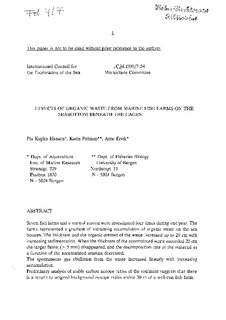| dc.contributor.author | Hansen, Pia Kupka | |
| dc.contributor.author | Ervik, Arne | |
| dc.contributor.author | Pittman, Karin | |
| dc.date.accessioned | 2012-08-21T14:31:11Z | |
| dc.date.available | 2012-08-21T14:31:11Z | |
| dc.date.issued | 1990 | |
| dc.identifier.citation | This report is not to be cited without prior reference to the authors | no_NO |
| dc.identifier.uri | http://hdl.handle.net/11250/104717 | |
| dc.description.abstract | Seven fish farms and a control station were investigated four times during one year. The
farms represented a gradient of increasing accumulation of organic waste on the sea
bottom. The thickness and the organic content of the waste increased up to 20 cm with
increasing sedimentation. When the thickness of the accumulated waste exceeded 20 cm
the larger fauna ( > 5 mm) disappeared, and the decomposition rate of the material as
a function of the accumulated amount decreased.
The spontaneous gas ebullition from the waste increased linearly with increasing
accumulation.
Preliminary analysis of stable carbon isotope ratios of the sediment suggests that there
is a return to original background isotope ratios within 30 m of a well-run fish farm. | no_NO |
| dc.language.iso | eng | no_NO |
| dc.publisher | ICES | no_NO |
| dc.relation.ispartofseries | ICES CM Documents;1990/F:34 | |
| dc.subject | fish farms | no_NO |
| dc.subject | oppdrettsanlegg | no_NO |
| dc.subject | marine environment | no_NO |
| dc.subject | havmiljø | no_NO |
| dc.title | Effects of organic waste from marine fish farms on the seabottom beneath the cages | no_NO |
| dc.type | Working paper | no_NO |
| dc.subject.nsi | VDP::Mathematics and natural science: 400::Zoology and botany: 480::Marine biology: 497 | no_NO |
| dc.subject.nsi | VDP::Agriculture and fishery disciplines: 900::Fisheries science: 920::Aquaculture: 922 | no_NO |
| dc.source.pagenumber | 15 s. | no_NO |
